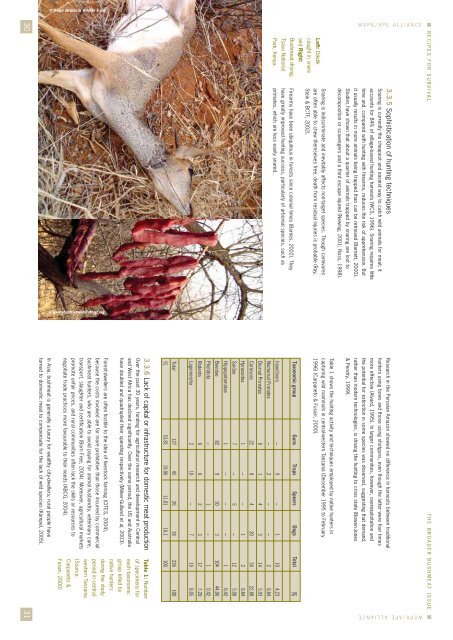Recipes for Survival_English_tcm46-28192
Recipes for Survival_English_tcm46-28192
Recipes for Survival_English_tcm46-28192
- No tags were found...
Create successful ePaper yourself
Turn your PDF publications into a flip-book with our unique Google optimized e-Paper software.
WSPA/APE ALLIANCERECIPES FOR SURVIVAL3.3.5 Sophistication of hunting techniquesSnaring is currently the cheapest and easiest way to catch wild animals <strong>for</strong> meat; itaccounts <strong>for</strong> 84% of village-based hunting harvests (WCS, 1996). Snaring requires littletime and, compared with hunting with firearms, reduces the risk of apprehension. Butit usually results in more animals being trapped than can be retrieved (Barnett, 2000).Studies have shown that about a quarter of animals trapped by snaring are lost todecomposition or scavengers and a third escape injured (Newing, 2001; Noss, 1998).Snaring is indiscriminate and inevitably affects non-target species. Though carnivoresare often able to chew themselves free, death from residual injuries is probable (Ray,Stein & BCTF, 2002).Firearms have been ubiquitous in <strong>for</strong>ests since colonial times (Barnes, 2002). Theyhave greatly improved hunting success, particularly of arboreal species, such asprimates, which are less easily snared.THE BROADER BUSHMEAT ISSUEResearch in the Peruvian Amazon showed no difference in harvests between traditionalhunters using bows and those using shotguns, even though the latter were four timesmore effective (Alvard, 1995). In larger communities, however, overexploitation andthe potential <strong>for</strong> extinction in some species was observed, suggesting that demand,rather than modern technologies, is driving the hunting to crisis state (Bowen-Jones& Pendry, 1999).Table 1 shows the hunting activity and techniques employed by native hunters incapturing wild mammals in central-western Tanzania (December 1995 to February1996) (Carpaneto & Fusari, 2000).3.3.6 Lack of capital or infrastructure <strong>for</strong> domestic meat productionOver the past 30 years, funding <strong>for</strong> agricultural research and development in Centraland West Africa has declined significantly. Over the same period, the US and Australiahave doubled and quadrupled their spending respectively (Milner-Gulland et al, 2003).Forest-dwellers are often hostile to the idea of livestock farming (CITES, 2004),because the costs involved are far more prohibitive than those incurred by commercialbushmeat hunters, who are able to avoid paying <strong>for</strong> animal husbandry, veterinary care,transport, slaughter and certification (Born Free, 2004). Moreover, agricultural marketspromote unfair prices, and rural communities often lack the skills or resources tonegotiate trade practices more favourable to their needs (ABCG, 2004).In Asia, bushmeat is generally a luxury <strong>for</strong> wealthy city-dwellers; rural people haveturned to domestic meat to compensate <strong>for</strong> the lack of wild species (Kümpel, 2005).31WSPA/APE ALLIANCE30Left: Dikdikcaught in snareand Right:Bushmeat drying,Tsavo NationalPark, Kenya.Taxonomic group Guns Traps Spears Dogs Total %Insectivors – 9 – 1 10 4.23Nocturnal Primates – 2 – – 2 0.84Diurnal Primates 6 1 4 3 14 5.93Carnivora 22 8 4 20 54 22.88Hyracoidea 1 – – 1 2 0.84Suidae 7 – 5 – 12 5.08Hippopotamidae 1 – – – 1 0.42Bovidae 82 9 10 3 104 44.06Pholidota – 1 – 1 0.42Rodenta 6 6 2 3 17 7.20Lagomorpha 2 10 – 7 19 8.05Total 127 45 26 38 236 100% 53.81 19.06 11.01 16.1 100Table 1: Numberof specimens <strong>for</strong>each taxonomicgroup killed bynative huntersduring the studyperiod in centralwesternTanzania(Source:Carpaneto &Fusari, 2000)© David Sheldrick Wildlife Trust© www.sheldrickwildlifetrust.org


